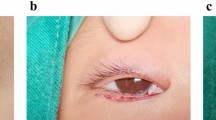Abstract
Purpose
To describe a simple technique for involutional entropion correction and to present the findings of a retrospective interventional case series study.
Methods
We studied a consecutive series of 414 patients (609 eyelids). Patients presenting with involutional entropion in the absence of lateral canthal tendon laxity underwent orbicularis oculi muscle (OOM) transposition from pretarsal position to corresponding preseptum without horizontal shortening or resection of the orbicularis muscle.
Results
Immediate resolution of entropion and associated ocular symptoms was achieved in 607 eyelids (99.67 %). An early postoperative complication was localized lid swelling that gradually subsided within one week. Over-correction occurred in six cases and resolved with pressure dressing, mostly one or two days post-operation. At final follow-up, a significant improvement in eyelid position was achieved in 579 eyelids (95.07 % ). There was mild recurrence of entropion in 30 eyelids (4.93 %). The mean follow-up was 6.84 months (range, 6–12 months).
Conclusions
Orbicularis oculi muscle transposition is a reasonably successful procedure with a high success rate, and is particularly suitable for patients for whom there exits overriding of the preseptal OOM over the pretarsal OOM.

Similar content being viewed by others
References
Vallabhanath P, Carter SR (2000) Ectropion and entropion. Curr Opin Ophthalmol 11:345–351
Dresner SC, Karesh JW (1993) Transconjunctival entropion repair. Arch Ophthalmol 111:1144–1148
Kakizaki H, Jinsong Z, Zako M, Nakano T, Asamoto K, Miyaishi O, Iwaki M (2006) Microscopic anatomy of Asian lower eyelids. Ophthal Plast Reconstr Surg 22:430–433
Nakauchi K, Mimura O (2012) Combination of a modified Hotz procedure with the Jones procedure decreases the recurrence of involutional entropion. Clin Ophthalmol 6:1819–1822. doi:10.2147/OPTH.S36819
Miletić D, Elabjer BK, Busić M, Elabjer E, Bosnar D (2012) Modified operative technique for involutional lower lid entropion. Coll Antropol 36:447–450
Hayashi K, Ohno-Matsui K, Moriyama M, Hayashi W, Mochizuki M (2011) Wide everting suture for involutional lower lid entropion. Nihon Ganka Gakkai Zasshi 115:529–534
Roberts MA, Baddeley P, Sinclair N, Lane CM (2012) The lower lid diamond: a simple entropion repair to correct both horizontal and lower-lid retractor laxity. Ophthal Plast Reconstr Surg 28:44–46. doi:10.1097/IOP.0b013e3182364a8e
Then SY, Salam A, Kakizaki H, Malhotra R (2011) A lateral approach to lower eyelid entropion repair. Ophthalmic Surg Lasers Imaging 42:519–522. doi:10.3928/15428877-20110901-04
Caldato R, Lauande-Pimentel R, Sabrosa NA, Fonseca RA, Paiva RS, Alves MR, José NK (2000) Role of reinsertion of the lower eyelid retractor on involutional entropion. Br J Ophthalmol 84:606–608
Kakizaki H, Chan WO, Takahashi Y, Selva D (2009) Overriding of the preseptal orbicularis oculi muscle in Caucasian cadavers. Clin Ophthalmol 3:243–246
Carter SR, Seiff SR, Grant PE, Vigneron DB (1998) The Asian lower eyelid: a comparative anatomic study using high-resolution magnetic resonance imaging. Ophthal Plast Reconstr Surg 14:227–234
Carter SR, Chang J, Aguilar GL, Rathbun JE, Seiff SR (2000) Involutional entropion and ectropion of the Asian lower eyelid. Ophthal Plast Reconstr Surg 6:45–49
Miller DG, Hesse RJ (1990) Involutional entropion of the upper lid. Ophthal Plast Reconstr Surg 6:16–20
Bleyen I, Doolman PJ (2009) The Wies procedure for management of trichiasis or cicatricial entropion of either upper or lower eyelids. Br J Ophthalmol 93:1612–1615
Barnes JA, Bunce C, Olver JM (2006) Simple effective surgery for involutional entropion suitable for the general ophthalmologist. Ophthalmology 113:92–96
Erb MH, Uzcategui N, Dresner SC (2006) Efficacy and complications of the transconjunctival entropion repair for lower eyelid involutional entropion. Ophthalmology 113:2351–2356
Acknowledgements
We gratefully acknowledge the valuable help by Dr. Zhen Xu, MD.
Conflict of interest
No author has any proprietary interest in the publication of this report.
Author information
Authors and Affiliations
Corresponding author
Rights and permissions
About this article
Cite this article
Ding, J., Chen, F., Zhai, W. et al. Orbicularis oculi muscle transposition for repairing involutional lower eyelid entropion. Graefes Arch Clin Exp Ophthalmol 252, 1315–1318 (2014). https://doi.org/10.1007/s00417-014-2694-3
Received:
Revised:
Accepted:
Published:
Issue Date:
DOI: https://doi.org/10.1007/s00417-014-2694-3




